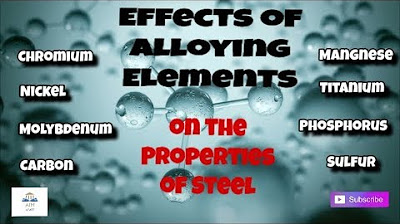Why do architects obsess over corten steel (and what exactly is it?)
Summary
TLDRCorton steel, also known as weathering steel, is an alloy that develops a protective rust layer over time, preventing further corrosion and giving it a rugged aesthetic. Initially used in railroad coal wagons, it entered architecture in the 1960s, becoming popular for its durability and blend of form and function. Architects favor it for its low maintenance, ability to age gracefully, and compatibility with various materials. However, it has limitations, such as susceptibility to breakdown in humid conditions and potential staining from water runoff.
Takeaways
- 🌟 Cor-Ten steel, also known as weathering steel, is a type of steel alloy that forms a stable protective layer of rust over time, which shields it from further corrosion.
- 🏭 Cor-Ten steel was developed in the 1930s by the United States Steel Corporation for use in railroad coal wagons due to its resistance to corrosive elements.
- 🏗️ Architect AOS Sarinen introduced Cor-Ten steel to architecture in the 1960s, using it in the John Deere world headquarters, highlighting its industrial look and durability.
- 🔍 The unique aesthetic and durability of Cor-Ten steel make it a favorite in architecture for its blend of form and function, requiring low maintenance and aging gracefully.
- 🛠️ Cor-Ten steel's chemical composition, including copper, chromium, nickel, phosphorus, manganese, and silicon, allows it to form a stable rust layer, known as a patina, which protects the steel.
- ⏱️ The rust patina on Cor-Ten steel can form in about 6 months, but chemical treatments can accelerate this process to as little as 1 hour.
- 🏙️ Cor-Ten steel is used in various architectural applications, from building facades and structural elements to public art installations and landscape features.
- 🌱 Cor-Ten steel's weathered appearance allows it to blend with natural surroundings, making it ideal for projects aiming for environmental harmony.
- 🔑 There are two types of Cor-Ten steel: Cor-Ten A and Cor-Ten B, each with different properties suitable for different applications, such as load-bearing or resistance to tension forces.
- ⚒️ Welding Cor-Ten steel requires specific techniques, with Cor-Ten A being more flexible and Cor-Ten B needing specialized welding methods to maintain strength and weather resistance.
- ⚠️ Cor-Ten steel has some disadvantages, including susceptibility to structural issues in constantly wet and humid conditions, and potential for staining nearby surfaces with its rust runoff.
Q & A
What is Cor-Ten steel and why is it significant to architects?
-Cor-Ten steel, also known as weathering steel, is a group of steel alloys designed to form a stable protective layer of rust that shields it from further corrosion. Architects appreciate it for its unique rugged aesthetic, durability, and low maintenance.
When was Cor-Ten steel first developed and for what initial purpose?
-Cor-Ten steel was first developed in the 1930s by the United States Steel Corporation. It was initially designed for use in railroad coal wagons due to its resistance to the corrosive effects of coal and weather.
Who was the visionary architect that introduced Cor-Ten steel into architecture?
-The visionary architect who introduced Cor-Ten steel into architecture was AOS Sarinen.
What is the significance of the John Deere world headquarters in the history of Cor-Ten steel usage in architecture?
-The John Deere world headquarters in Illinois was one of the first architectural applications of Cor-Ten steel. It marked the beginning of Cor-Ten Steel's journey into the world of architecture.
What are the alloy elements included in Cor-Ten steel, and what is their role?
-Cor-Ten steel is made of alloy elements including copper, chromium, nickel, phosphorus, manganese, and silicon. These elements are balanced to create a material that forms a stable rust layer when exposed to the elements.
How long does it take for the protective rust layer, or patina, to form on Cor-Ten steel?
-The rust layer, or patina, on Cor-Ten steel can take around 6 months to form naturally, but chemical treatments can speed up the process to as little as 1 hour.
What is the difference between Cor-Ten A and Cor-Ten B steel?
-Cor-Ten B has a slightly higher copper content than Cor-Ten A, resulting in a deeper, more intense color as it ages. Cor-Ten A has a higher yield strength, making it suitable for structural applications, while Cor-Ten B offers better resistance to tension forces.
What are some disadvantages of using Cor-Ten steel in architectural projects?
-Cor-Ten steel works best in environments where it can dry out regularly. In constantly wet and humid conditions, the protective rust layer can break down leading to structural issues. Additionally, rust runoff can stain nearby surfaces.
How does Cor-Ten steel's patina affect its maintenance requirements?
-The patina on Cor-Ten steel adheres tightly to the surface, providing long-term durability and acting as a protective barrier against further corrosion, which means it requires minimal maintenance.
In what types of architectural projects is Cor-Ten steel commonly used?
-Cor-Ten steel is used in building facades, structural elements, public art installations, and landscape features. Its weathered appearance allows it to blend seamlessly with natural surroundings.
What are some welding considerations when working with Cor-Ten steel?
-Both Cor-Ten A and Cor-Ten B are weldable, but they require different techniques. Cor-Ten A can be welded using standard methods, while Cor-Ten B needs specialized welding techniques involving cored wire or filler material.
Outlines

This section is available to paid users only. Please upgrade to access this part.
Upgrade NowMindmap

This section is available to paid users only. Please upgrade to access this part.
Upgrade NowKeywords

This section is available to paid users only. Please upgrade to access this part.
Upgrade NowHighlights

This section is available to paid users only. Please upgrade to access this part.
Upgrade NowTranscripts

This section is available to paid users only. Please upgrade to access this part.
Upgrade NowBrowse More Related Video
5.0 / 5 (0 votes)





